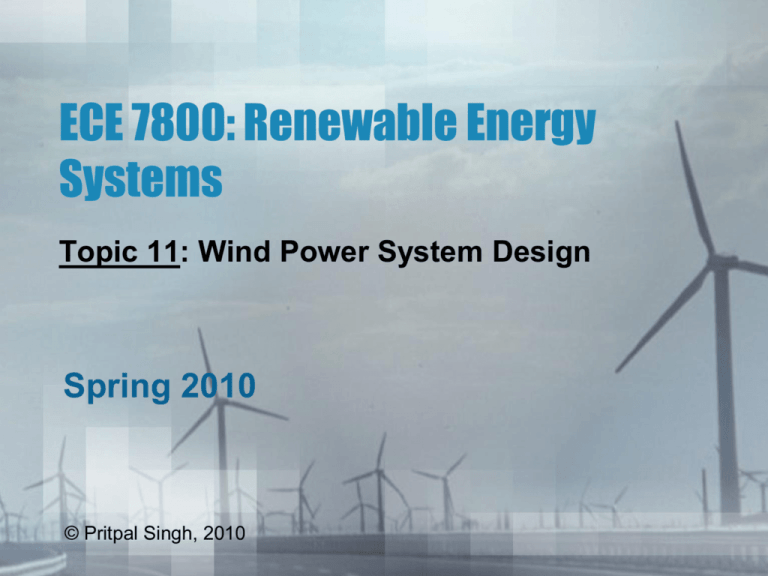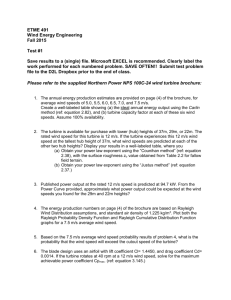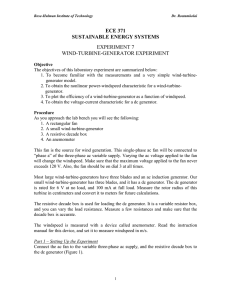ECE 7800: Renewable Energy Systems
advertisement

ECE 7800: Renewable Energy Systems Topic 11: Wind Power System Design Spring 2010 © Pritpal Singh, 2010 Wind Resource The average power in the wind is given by: Pavg 1 1 3 Av A v 3 2 avg 2 avg We therefore need to determine the average of the value of the cube of the wind velocity. We assume a statistical variation of the wind velocity designated by a windspeed probability density function as shown below: Wind Resource Statistics The average value of the cube of the wind velocity is given by: (v 3 ) avg v 3 . f (v)dv 0 where f(v) is the probability density function. There are two common types of probability density functions that are used to describe the statistical variation of the wind resource – Weibull statistics and Rayleigh statistics. Weibull Probability Density Function The Weibull probability density function is given by: k 1 k k v v f (v) exp c c c where k is called the shape parameter and c the scale parameter. The probability density function with k=1,2, and 3 are shown below: Rayleigh Probability Density Function The Rayleigh probability density function is given by: 2 2v v f (v) 2 exp c c The Rayleigh probability density function for different values of c is shown below: Average Power in Rayleigh Distribution The average power in the wind for a Rayleigh distribution can be calculated as follows: 2 3 3 v 3 3 2v v f (v)dv v 2 exp dv c c 4 c 0 0 (v 3 ) avg This can also be expressed as: (v ) avg 3 6 v 3 1.91v 3 where v is the average wind speed. Thus, 6 1 P . Av 3 2 Average Power in Rayleigh Distribution (cont’d) Example 6.10 Wind Resource Data Some actual wind data for Altamont Pass, CA together with a Rayleigh probability distribution function with the same average wind speed is shown in the figure below: Wind Power Classifications The procedure demonstrated in example 6.10 is commonly used to estimate average wind power density (W/m2) in a region. Winds are classified by average wind speed as shown in the below table. Wind Resource Maps Wind resource maps, as shown below, are available from NREL. Wind Resource Potential The potential for wind energy, based on class 3 winds or higher, are shown by states in the table below: Simple Estimation of Wind Energy How much of the wind energy can be converted to electrical energy? Average wind turbine efficiency can be used to estimate wind energy delivered on an annual basis. However, this information has limited utility in terms of detailed wind energy planning. Example 6.11 Wind Farms Wind turbines arranged in wind farms must be designed so that upwind turbines do not interfere with downwind turbines. Theoretical studies on square arrays of wind turbines have been performed to determine the effect of interference on array output. We can define a quantity called the “array efficiency” which is the output of the array divided by the output of the array without interference. Wind Farm Optimization The array efficiency of a square array of wind turbines as a function of tower spacing is shown below: Wind Farm Optimization The optimum arrangement of a wind farm is shown below: Energy Potential for a Wind Farm Example 6.12 Wind Turbine Performance Calculations The calculations until now have assumed an average wind turbine efficiency. However, we now want to look at more detailed/accurate calculations. Aerodynamics of Blades A conventional airfoil achieves lift based on Bernoulli’s principle. Air moving over the top of the airfoil has a longer way to go than over the bottom and so must move faster. This results in lower pressure at the top than at the bottom resulting in lift. In a wind turbine additional lift on the blade is created by the wind. Aerodynamics of Blades (cont’d) Increasing the angle of attack of the blade increases the lift up to a point. Beyond this point, the flow of the air over the blade changes from laminar to turbulent, resulting in loss of lift. This is called “stalling” of the blade. Wind Turbine Power Curve The most important information for a specific wind turbine is the power curve which shows the power delivered by a wind turbine as a function of wind speed. An example of a power curve is shown below: Wind Turbine Power Curve (cont’d) Features of the wind turbine power curve: Cut-in Windspeed – no power generated for windspeeds less than this value. Rated windspeed – as velocity increases above cut-in windspeed, power increases as the cube of the windspeed up to the rated windspeed at which point the generator is delivering as much power as it is designed for. Cut-out windspeed – at high windspeeds damage can be done to the wind turbine and so the turbine is shut down. This happens at the cut-out windspeed and the power output is zero. Wind Turbine Overspeed Control The generator can be operated above its rated speed without damage using one of three control approaches: 1) Active Pitch Control - an electronic system monitors the generator output and if it exceeds rated output, the pitch of the blades is adjusted with a hydraulic system. 2) Passive Stall Control - the blades are designed to automatically reduce efficiency when winds are too strong. 3) Active Stall Control - the blades are designed to automatically stall when winds are too strong. Wind Turbine Optimization Two ways can be used to optimize the performance of a wind turbine – the rotor diameter may be increased, and the generator size may be increased. Their effects are shown below: Wind Speed Cumulative Distribution Function See text pp. 357-360 Real Power Curves The power curves for three large wind turbines is shown below: Estimating Real Wind Energy Output The power curves for the turbines can be combined with wind speed vs. time data to determine the energy output for a wind system. If wind data for a location are available, this procedure may be used. However, if complete data is not available, usually Weibull statistics are used to estimate the wind resource. If only average wind speed is available, Rayleigh statistics are used to estimate the wind resource. Estimating Real Wind Energy Output (cont’d) The wind resource probability distribution may be discretized. The probability that the wind speed is between v-Δv/2 and v+Δv/2 v v / 2 = f (v)dv f (v)v v v / 2 Thus we can discretize a continuous speed probability distribution function by stating that the probability that the wind blows at a speed V is f(V). This turns out to be a reasonable assumption. Estimating Real Wind Energy Output (cont’d) Example 6.15 Estimating Real Wind Energy Output (cont’d) Estimating Real Wind Energy Output (cont’d) Estimating Real Wind Energy Output (cont’d) Capacity Factor for Wind Energy Systems The capacity factor for a wind energy system is the fraction of the energy generated by the wind energy system compared to what it potentially could produce if it operated at rated power for every hour of the year. Thus, for example 6.15, CF = 2.8561 x 106 kWh/yr = 32.5% 1000kW x 8760h/yr Capacity Factor for Wind Energy Systems (cont’d) Suppose we want to estimate the capacity factor for a wind energy system when very little is known about the site or the wind turbine. The capacity factor for a NEG Micon 1000/60 wind turbine as a function of wind speeds (assuming Rayleigh statistics) is shown below: Capacity Factor for Wind Energy Systems (cont’d) For wind speeds in the range 4-10 m/s (9-22 mph) CF varies linearly with wind speed. A linear curve fit to this portion gives: CF = 0.087 V – 0.278 For the NEGMicon 1000/60 (PR=1000kW; D=60m), it turns out PR = 0.278 ! D2 Thus, for this particular turbine, CF = 0.087 V – PR/D2 Capacity Factor for Wind Energy Systems (cont’d) It turns out that this equation works quite well as a means of estimating the capacity factor for many wind turbines. Using this expression, for CF we can estimate the energy delivered from a turbine with diameter D (m) and rated power PR (kW) in Rayleigh winds with average speed V (m/s) by: Annual energy (kWh/yr) PR (kW ) = 8760.PR (kW )0.087V (m / s) 2 D(m) Capacity Factor for Wind Energy Systems (cont’d) Example 6.17









